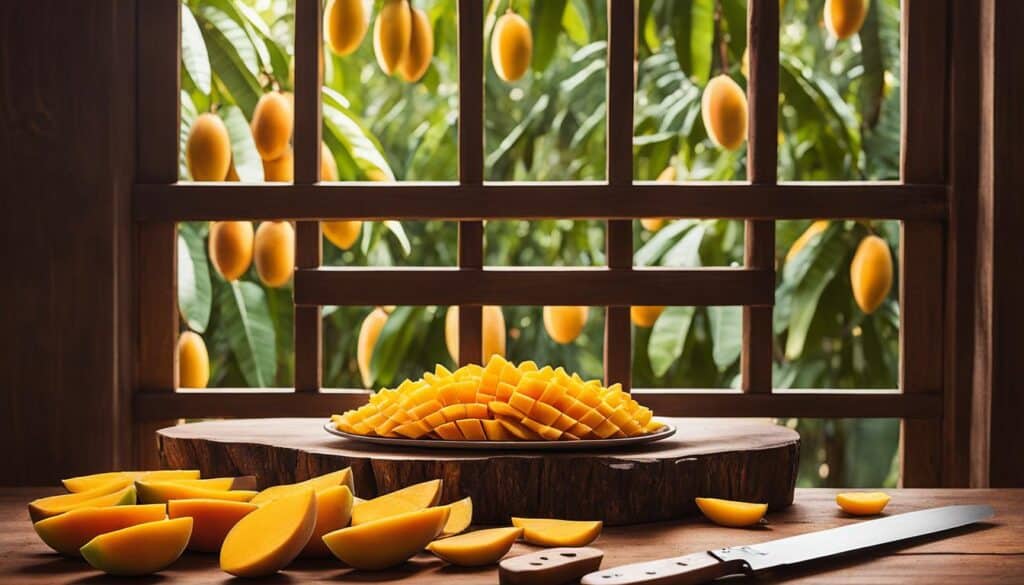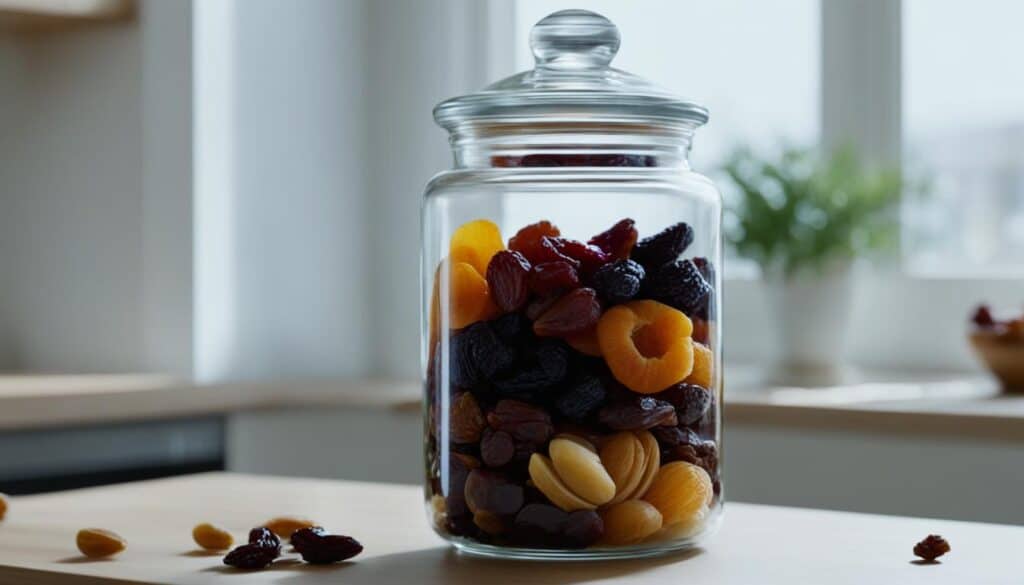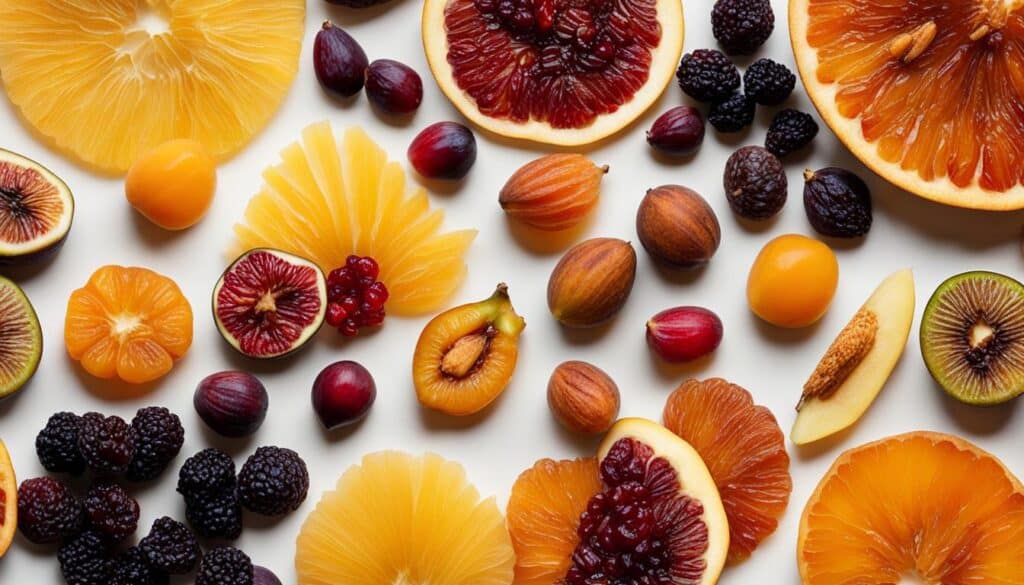Have you ever wondered how fruit goes from being fresh and juicy to dry and flavorful? The process of drying fruit is a fascinating one that involves removing the water content while preserving the delicious flavors and valuable nutrients. Join me as I explore the art and science behind fruit drying and discover the various methods used to achieve that perfect dried fruit consistency.
There are several different techniques used in the drying process, each with its own benefits and outcomes. From low heat to air drying and even freeze drying, each method has its own unique way of removing moisture from the fruit while maintaining its taste and texture.
In this article, we’ll delve into the specifics of drying two popular fruits: pineapples and mangoes. We’ll explore the step-by-step processes involved in drying these fruits, along with the preservation methods used to extend their shelf life. Additionally, we’ll discuss the nutritional benefits of dried fruit and share some creative ways to incorporate it into your diet.
Key Takeaways:
- Drying fruit involves removing water content while preserving flavors and nutrients.
- Various methods like low heat, air drying, and freeze drying are used in the fruit drying process.
- Pineapples and mangoes are commonly dried fruits with unique drying techniques.
- Dried fruit offers nutritional benefits and can be used in various recipes and dishes.
- Practice portion control and consume dried fruit in moderation for a balanced diet.
The Nutritional Benefits of Dried Fruit
Dried fruit offers a plethora of health benefits that make it a nutritious and delicious addition to any diet. Packed with essential vitamins, minerals, and dietary fiber, dried fruit is a convenient and versatile snack option. Let’s explore the nutritional value and advantages of incorporating dried fruit into your daily routine.
Rich in Vitamins and Minerals
Dried fruit is a concentrated source of vitamins and minerals that are essential for overall well-being. From vitamin A, C, and E to potassium, magnesium, and iron, dried fruit packs a powerful nutrient punch in a small package. These valuable nutrients contribute to maintaining a healthy immune system, supporting bone health, and promoting proper functioning of various bodily processes.
Dietary Fiber for Digestive Health
Fiber is an important component of a balanced diet, and dried fruit is an excellent source of dietary fiber. This fiber aids in maintaining a healthy digestive system, preventing constipation, and regulating bowel movements. Incorporating dried fruit into your meals or snacks can promote optimal digestion and help you feel satisfied for longer periods.
Heart-Healthy Fats
Many dried fruits, such as almonds and walnuts, contain heart-healthy fats that are beneficial for cardiovascular health. These unsaturated fats, including omega-3 fatty acids, can help lower cholesterol levels, reduce the risk of heart disease, and improve overall heart function. Including a handful of nuts along with dried fruit in your diet can have a positive impact on heart health.
Antioxidants for Cell Protection
Dried fruits are rich in antioxidants, which play a crucial role in protecting cells from damage caused by harmful free radicals. Antioxidants help reduce inflammation, support the immune system, and contribute to healthier aging. By consuming dried fruit, you can introduce a variety of antioxidants into your diet and promote overall well-being.
Blood Sugar Regulation
The natural sugars found in dried fruit are complemented by dietary fiber, which helps regulate blood sugar levels. Unlike processed sugary snacks, dried fruit has a lower glycemic index, meaning it releases sugar into the bloodstream at a slower pace, preventing sharp sugar spikes. This makes dried fruit a suitable option for individuals with diabetes or those aiming to manage their blood sugar levels.
Cognitive Health Benefits
The antioxidants and nutrients present in dried fruit can contribute to cognitive health and brain function. Research suggests that the consumption of dried fruits, such as blueberries and cranberries, may improve memory, concentration, and overall cognitive performance. Including a variety of dried fruits in your diet can help promote brain health and enhance cognitive abilities.
Overall, dried fruit offers a delicious and nutritious way to reap numerous health benefits. Its vitamin and mineral content, dietary fiber, heart-healthy fats, antioxidants, blood sugar regulation properties, and cognitive health benefits make dried fruit an excellent choice for those seeking a wholesome snack option.
The Process of Drying Pineapples
To create dehydrated pineapple, the fruit undergoes a meticulous process that involves peeling, coring, and slicing it into uniform pieces. This preparation ensures even drying and consistent texture throughout the dried fruit.
The next step is to subject the pineapple slices to low heat or air drying methods. These methods effectively remove the moisture content from the fruit while preserving its natural flavors and nutritional benefits. The drying process enhances the sweetness of the pineapple, creating a concentrated burst of tropical flavor in every bite.
During the drying process, some manufacturers may use sulfur dioxide as a preservative. Sulfur dioxide helps maintain the color and prolong the shelf life of dehydrated pineapple. Rest assured, this preservative is safe for consumption within regulated limits.
Dehydrated pineapple is a versatile snack that can be enjoyed on its own or incorporated into various recipes. Its chewy texture and intense pineapple flavor make it a popular choice for adding a tropical twist to baked goods, trail mixes, or even savory dishes.
Why Choose Dehydrated Pineapple?
Dehydrated pineapple offers several advantages over fresh pineapple. First, it has a significantly longer shelf life, allowing you to enjoy the delicious taste and health benefits of pineapple throughout the year. The dehydration process also intensifies the natural sweetness of the fruit, making it a satisfying and guilt-free snack option.
Furthermore, dehydrated pineapple is lightweight and portable, making it convenient for on-the-go snacking or packing in lunches. It provides a concentrated source of essential vitamins, minerals, and dietary fiber that can support your overall well-being.
“Dehydrated pineapple is a flavorful and nutritious alternative to fresh fruit, offering a convenient way to enjoy the taste of pineapple anytime, anywhere.”
– Pineapple Lover Magazine
Whether you’re an avid pineapple enthusiast or simply looking for a healthy and delicious snack, dehydrated pineapple is a fantastic choice. Its vibrant flavor, long shelf life, and nutritional benefits make it a versatile addition to your pantry.
| Nutritional Benefits of Dehydrated Pineapple | Per 100g |
|---|---|
| Calories | 350 |
| Total Fat | 0g |
| Carbohydrates | 94g |
| Dietary Fiber | 8g |
| Sugar | 51g |
| Protein | 1g |
| Potassium | 600mg |
| Vitamin C | 20mg |
The Art of Drying Mangoes
When it comes to drying mangoes, the process requires careful selection and preparation. Drying mangoes involves choosing ripe and flavorful varieties such as Ataulfo or Kent, renowned for their sweetness. By selecting these delicious mangoes, the resulting dehydrated mangoes retain their tropical flavor and chewy texture.
To begin the drying process, the mangoes are peeled and sliced into uniform pieces. Pre-treating the slices with lemon juice is essential to prevent browning and maintain their appealing color. This simple step ensures that the mango dehydration process leaves the fruit visually appealing.
Once pre-treated, the mango slices are ready for dehydration. There are several methods to accomplish this, including using a food dehydrator, oven, or air fryer. Each method removes the moisture from the mangoes, preserving their natural sweetness and intensifying the flavors.
Whether utilizing a food dehydrator, oven, or air fryer, it is important to follow the appropriate temperature and time settings based on the selected drying method. This ensures consistent and even drying, resulting in perfectly dried mangoes that can be enjoyed as a snack or used in various culinary creations.

image above visualizes the enticing process of drying mangoes, highlighting the vibrant transformation of fresh mango slices into dehydrated treasures.
Different Types of Dried Fruits
Dried fruit is available in a wide range of types, each offering its own unique flavor and nutritional profile. Whether you’re looking for a sweet snack or a versatile ingredient for your recipes, there’s a dried fruit out there to suit your taste and dietary needs.
Here are some popular dried fruits:
- Raisins: These small, wrinkled fruits are rich in iron and fiber, making them a nutritious choice for boosting your energy levels.
- Apricots: Packed with vitamins A and C, dried apricots provide a tangy, sweet flavor. They make a delicious addition to both sweet and savory dishes.
- Dates: Known for their natural sweetness, dates are high in fiber and provide essential minerals like potassium. They’re often used in baking or enjoyed as a healthy snack on their own.
- Cranberries: Tart and slightly sweet, dried cranberries are a great source of antioxidants and vitamin C. They add a burst of flavor to salads, trail mixes, and baked goods.
When comparing different dried fruits, it’s important to consider the nutritional benefits, taste, and applications. This helps you make informed decisions based on your preferences and dietary requirements.
Nutritional Comparison of Popular Dried Fruits
| Dried Fruit | Calories | Carbohydrates (g) | Fiber (g) | Vitamin C (mg) | Potassium (mg) | Iron (mg) |
|---|---|---|---|---|---|---|
| Raisins | 108 | 29 | 2 | 0 | 322 | 1 |
| Apricots | 48 | 12 | 2 | 1 | 259 | 1 |
| Dates | 66 | 18 | 2 | 0 | 167 | 0 |
| Cranberries | 123 | 33 | 4 | 1 | 68 | 0 |
As you can see from the table above, each dried fruit offers its own nutritional composition. By considering the calorie content, carbohydrate, fiber, and essential nutrients, you can choose the dried fruit that aligns with your dietary goals and preferences.

Storage and Shelf Life of Dried Fruit
Proper storage is essential for maintaining the freshness and quality of dried fruit. Whether you have a variety of dried fruits in your pantry or you love to make your own dried fruit at home, knowing how to store them correctly will ensure they stay delicious for longer.
When it comes to storing dried fruit, one of the key considerations is preventing moisture absorption. Moisture can quickly lead to spoilage and the growth of mold, ruining the taste and texture of the dried fruit. To keep your dried fruit in optimal condition, follow these guidelines:
- Use airtight containers: Transfer your dried fruit to airtight containers, such as glass jars or resealable bags. This helps create a barrier against moisture and ensures the fruit stays fresh. Make sure to close the containers tightly to maintain a proper seal.
- Choose a cool, dark place: Store your dried fruit in a cool and dark location, such as a pantry or cupboard. Avoid areas that are exposed to direct sunlight or heat sources, as this can cause the fruit to lose its flavor and nutritional value.
- Consider vacuum sealing: If you have larger batches of dried fruit or want to store them for an extended period, vacuum sealing can be a great option. Vacuum-sealed bags remove all the air, further minimizing moisture contact and prolonging shelf life.
While refrigeration can offer extra protection, it is not strictly necessary for preserving dried fruit. However, if you live in a particularly humid or warm climate, storing dried fruit in the refrigerator can help extend its shelf life.

Remember to label your containers with the type of dried fruit and the date of storage. This will help you keep track of freshness and ensure you use them in a timely manner.
“Proper storage is the key to maintaining the quality and taste of dried fruit. By keeping them in airtight containers in a cool, dark place, you can enjoy their deliciousness for longer.” – Me
| Dried Fruit | Storage Guidelines | Shelf Life |
|---|---|---|
| Raisins | Store in an airtight container in a cool, dark place | 6-12 months |
| Apricots | Transfer to an airtight container and store in the refrigerator | 6-12 months |
| Mangoes | Vacuum seal for longer shelf life or store in an airtight container in a cool place | 6-12 months |
| Dates | Keep in an airtight container at room temperature | 12-18 months |
By following these storage techniques and paying attention to the shelf life of different dried fruits, you can enjoy their natural sweetness and nutritional benefits for months to come.
Creative Uses for Dried Fruit
Dried fruit is not just a healthy snack; it’s also a versatile ingredient that adds a natural sweetness and nutritional benefits to a wide range of dishes. Here are some creative ways to incorporate dried fruit into your cooking:
1. Enjoy as a Standalone Snack
When you’re craving a quick and nutritious snack, reach for a handful of dried fruit. Whether it’s sweet and chewy raisins or tangy dried cranberries, dried fruit provides a burst of flavor and energy to keep you going throughout the day.
2. Mix with Nuts and Seeds for a Healthy Trail Mix
Create your own custom trail mix by combining dried fruit with your favorite nuts and seeds. The combination of flavors and textures makes for a satisfying and nutritious snack. Try mixing dried cherries, almonds, and pumpkin seeds for a delicious blend.
3. Add to Salads
Elevate your salads by adding dried fruit for a touch of sweetness. Dried apricots, cranberries, or figs can add a burst of flavor to a green salad or a grain-based salad like quinoa or couscous.
4. Enhance Baking Recipes
Dried fruit is a fantastic addition to baked goods, adding both flavor and texture. Try adding dried blueberries to muffins, chopped dried apples to cookies, or dried cherries to bread for a delicious twist on traditional recipes.
5. Boost Nutrition in Smoothies
Give your smoothies an extra dose of nutrients by throwing in some dried fruit. Dates, prunes, or dried mango can add natural sweetness and a creamy texture to your favorite smoothie recipes.
“Dried fruit is a fantastic addition to baked goods, adding both flavor and texture.”
Dried fruit is a versatile and nutritious ingredient that can elevate your meals and snacks. Whether you’re enjoying it as a standalone snack, incorporating it into baked goods, or adding it to salads or smoothies, dried fruit is sure to bring a burst of flavor and a dose of health benefits to your dishes.
Health Benefits of Dried Fruit
When it comes to dried fruit, the health benefits are aplenty. Not only does dried fruit provide a burst of natural sweetness, but it also packs a powerful nutritional punch. Let’s explore the advantages of incorporating dried fruit into your diet:
- Nutrient-rich: Dried fruit is a concentrated source of essential vitamins, minerals, and fiber. It contains a variety of nutrients that can support overall health and well-being.
- Heart health: Certain dried fruits, such as raisins and prunes, contain heart-healthy nutrients like potassium and fiber. These nutrients can help lower blood pressure, reduce cholesterol levels, and improve heart health.
- Weight management: Dried fruit is a satisfying snack option that can help curb cravings and manage weight. The fiber content in dried fruit promotes feelings of fullness, preventing excessive snacking and aiding in weight control.
- Promotes digestive health: The high fiber content in dried fruit supports a healthy digestive system by preventing constipation and promoting regular bowel movements.
- Antioxidant properties: Dried fruits, such as berries, apricots, and prunes, are rich in antioxidants. These compounds help protect against cellular damage caused by free radicals, reducing the risk of chronic diseases.
- Bone health: Dried fruit, such as dried figs and dates, are excellent sources of calcium and magnesium. These minerals are essential for maintaining strong bones and reducing the risk of osteoporosis.
- Helps with nutrient absorption: The fiber in dried fruit aids in nutrient absorption by slowing down the digestion process. This allows the body to better absorb important vitamins and minerals.
- Regulates blood sugar levels: Despite their natural sweetness, dried fruits have a low glycemic index, meaning they have a minimal impact on blood sugar levels. This makes them a suitable option for individuals with diabetes or those looking to manage their blood sugar.
- Supports cognitive health: Dried fruits, such as blueberries and cherries, are rich in antioxidants that help reduce inflammation and oxidative stress in the brain. This can support cognitive function and reduce the risk of age-related cognitive decline.
- Reduces inflammation: The antioxidants and phytochemicals present in dried fruit have anti-inflammatory properties, which can help reduce inflammation in the body and lower the risk of chronic diseases.
- Aids in stress reduction: Some dried fruits, like apricots, contain nutrients like magnesium and vitamin C, which can help reduce stress levels and promote overall well-being.

“Incorporating dried fruit into your diet is not only delicious but also a convenient way to boost your nutritional intake. From supporting heart health to promoting digestion and cognitive function, dried fruit offers a wide array of health benefits.”
Portion Control and Moderation with Dried Fruit
While dried fruit offers many health benefits, it is important to exercise portion control and consume it in moderation. Dried fruit is calorie-dense, so moderation is key to avoid excessive calorie intake. Enjoying dried fruit as part of a balanced diet ensures that the benefits are reaped without overloading on calories.
Conclusion
After exploring the fascinating process of drying fruit, it is clear that this preservation method not only retains the flavors but also maintains the nutritional value of the fruit. Pineapples and mangoes, two popular fruits, can be dried using various techniques such as low heat, air drying, or freeze drying.
In addition to their delicious taste, dried fruits offer a wide range of health benefits. They are rich in vitamins, minerals, and dietary fiber, which support heart health, weight management, and digestive health. Incorporating dried fruit into a balanced diet can provide an array of nutrients and contribute to overall well-being.
While dried fruit is undoubtedly beneficial, it is crucial to practice portion control and consume it in moderation. Dried fruit is calorie-dense, and excessive consumption can lead to unwanted calorie intake. By enjoying dried fruit in appropriate portions, individuals can enjoy its benefits without compromising their daily caloric goals.
Overall, dried fruit is a versatile and nutritious addition to meals and snacks. Whether enjoyed as a standalone snack, mixed into recipes, or added to salads, dried fruit adds variety and nutritional value to any dish. With its enticing flavors and health benefits, dried fruit is a delightful way to savor the taste of fruits while reaping their numerous advantages.
FAQ
How is fruit dried?
Fruit can be dried using methods like low heat, air drying, or freeze drying to remove moisture and preserve flavors and nutrients.
What are the nutritional benefits of dried fruit?
Dried fruit is rich in vitamins, minerals, dietary fiber, and heart-healthy fats. It provides antioxidants and offers benefits for digestion, bone health, blood sugar regulation, and cognitive health.
How are pineapples dried?
Pineapples are peeled, cored, sliced, and then subjected to low heat or air drying methods to remove moisture while preserving the natural flavors and nutritional benefits. Sulfur dioxide is often used as a preservative to maintain color and extend shelf life.
What is the process of drying mangoes?
To dry mangoes, ripe varieties like Ataulfo or Kent are peeled, sliced, and pre-treated with lemon juice to prevent browning. They are then dehydrated using methods like a food dehydrator, oven, or air fryer, maintaining the tropical flavor and chewy texture.
What are the different types of dried fruits?
Some popular dried fruits include raisins, apricots, dates, and cranberries. Each type has its unique flavor and nutritional profile.
How should dried fruit be stored?
It is best to store dried fruit in airtight containers in a cool, dark place to prevent moisture absorption and extend shelf life. Vacuum sealing is an option for larger batches, and while refrigeration provides extra protection, it is not strictly necessary.
What are some creative uses for dried fruit?
Dried fruit can be enjoyed as a standalone snack, mixed with nuts and seeds for a healthy trail mix, or added to salads, baking recipes, or smoothies for extra flavor and texture.
What are the health benefits of dried fruit?
Dried fruit offers numerous health benefits, including heart health, weight management, digestive health, antioxidant properties, bone health, nutrient absorption, blood sugar regulation, cognitive health, protein content, inflammation reduction, and stress reduction.
How should dried fruit be consumed in moderation?
While dried fruit is nutritious, it is important to exercise portion control due to its calorie density. Consuming dried fruit as part of a balanced diet ensures the benefits without excessive calorie intake.
What are the main takeaways about dried fruit?
Drying fruit is a fascinating process that preserves flavors and nutritional value. Different methods are used for specific fruits like pineapples and mangoes. Dried fruit offers various health benefits and can be used in a wide range of dishes. It is important to store dried fruit properly and practice moderation when consuming it.





Leave a Reply